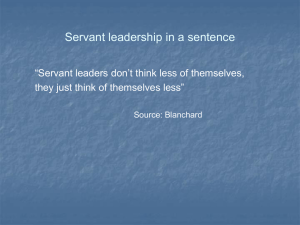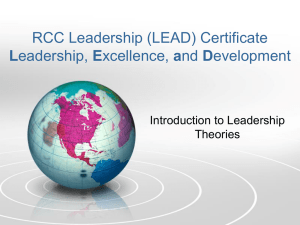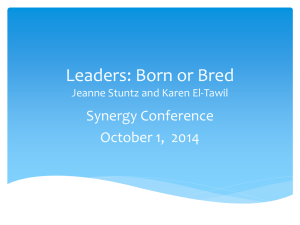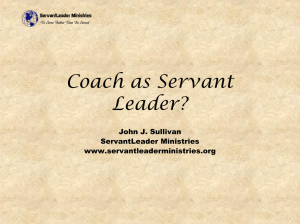Listening Effectively
advertisement
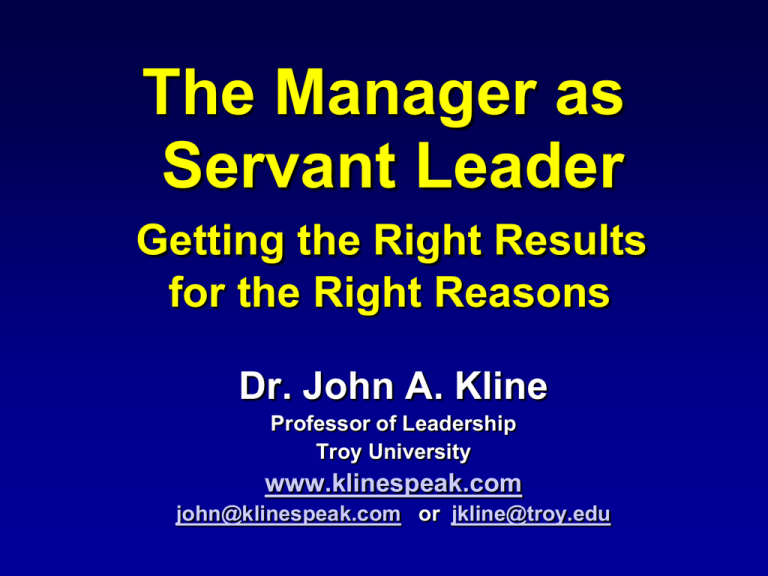
The Manager as Servant Leader Getting the Right Results for the Right Reasons Dr. John A. Kline Professor of Leadership Troy University www.klinespeak.com john@klinespeak.com or jkline@troy.edu L & M: Questionable Distinctions • Leaders lead people; managers manage things • Leaders work for change; managers work for stability • Leaders focus on long-term; managers on short-term • Leaders have a vision; managers have objectives • Leaders appeal to the heart; managers to the head • Leaders find new roads; mangers take existing roads • Leaders—transformational; managers—transactional – Transactional: reward/punishment; do what I tell you – Transformational: inspires, motivates, encourages; often charismatic (but not narcissistic); transforms people and the organization • While I question these seven distinctions, I said this: In a 2008 article for the Armed Forces Comptroller called “Managing People and Processes,” I wrote: • “Leadership without management is vision without fulfillment.” I also believe • “Management without leadership often yields stagnation and lost opportunities.” Therefore, the point is this: • Managers must also be leaders. • The question is: What kind of leaders? Great Leaders • Inspire, motivate, encourage and promote transformation of an organization and its people. (Transformational Leadership) • Find good people, give them responsibility, and then help them succeed. (Shared Leadership) • Serve others and the organizations to which they belong. (Servant Leadership) Implies shared & transfor… Please keep this point in mind: Leaders always bear responsibility for what happens. None of the statements above imply absence of a leader who bears ultimate responsibility; no organization will succeed for any length of time without one person at the top. Overview of Servant Leadership • Traits or Attributes • Styles • Focus • Remember, the main idea today is: The Manager as Servant Leader: Getting the Right Results for the Right Reasons Three Key Attributes of Servant Leaders ”Great leaders are servant leaders because it is the best way for them to serve the organization and others.” • Character—who you are • Competency—what you can do • Confidence—belief in yourself and your ability to lead others Character: A list of some qualities • Inspiring—confident; get best out of people • Courageous—persevering to accomplish a goal • Honest—sincerity, integrity, displaying candor • Fair-minded—sensitive to well-being of others • Forward Looking—having a vision for the future • How would you rank these? 1 is top; 5 is last Competency: OPM’s Five Requisites to be an SES “Manager” • Lead change • Lead people • Business acumen • Results driven • Communicate/Build Coalitions Confidence Comes mainly from possessing Character and Competence • Exhibit Character—who you are and who you seem to be; and they should be consistent • Demonstrate Competence—know what you’re talking about; and show it • Think Strategically Have the big picture Have a plan Set solid priorities • Show You can Handle Adversity • Look, Act & Feel Confident Styles of Leadership—a test Three Basic Styles of Leadership • Authoritarian • Participative • Delegative Authoritarian • Leader tells what to do and how to do it • Not simply bossing other people around • Valuable if time is short, information is known, and followers are motivated • Effective if others recognize and respect your authority; not effective if they don’t • All leaders must be able to show authority Participative • Lets others participate in decision-making • Effective if the leader has only part of the information; followers have other information • Promotes teamwork and sound decisions • Leader still responsible for decisions • Important point: The leader maintains final authority and responsibility Delegative • Leader delegates specific responsibilities • Delegates expected to make decisions • Effective when leader trusts others and knows they have necessary competencies • Leader still responsible for decisions • Important point: The leader maintains final authority and responsibility Important Points The most effective leaders use all three styles depending on the situation; that is, they use each style at appropriate times You can be a servant leader irrespective of the style you use; in fact, servant leaders must be able to use all three styles Effective servant (sharing/transformational) leaders focus on both the task and the people doing it; and they avoid over-focusing on one or the other — let’s talk about this Task-focused Leaders Basic assumptions • People can’t or won’t direct their own behavior • Individuals are often indifferent to group goals Leaders often communicate this by • Telling not only what to do but how to do it • Controlling or discouraging open communication Followers often respond by • Performing to the leader’s “low” expectations • Resisting responsibility; starting rumors; trying to discover “company secrets” People-focused Leadership Basic assumptions • People are intrinsically motivated and will assume responsibility; people are basically good • Conflicts/tensions must be reduced at all costs Leaders often communicate this by • Emphasizing individual needs over organizational ones • Letting individual desires override task accomplishment Followers often respond by • Creating an appearance of harmony in the group or organization while relieving conflicts elsewhere • Showing dissatisfaction when leaders issue directives Dual-focused Leadership Basic assumptions • Flexibility is important • Individual and group needs should be consistent Leaders communicate this by • Demonstrating a willingness to adjust & be flexible • Expecting a certain return for flexibility; task must be accomplished • Followers respond with • Increased esteem for self and group; more open communication • Increased productivity while bringing individual behavior in line with group objectives So what can we conclude? • Effective leaders show concern about both the task and the people • You need to know what style—authoritarian, participative and delegative—fits you, the people you lead and the situation • You will be most effective if you possess strong character, competence and confidence • Great leaders are servant leaders because it is the best way for them to serve the organization and others. Characteristics of Servant-Leaders • Communicate: vision; plan; why to follow • Listen: for information; to understand people • Implement change • Mentor future leaders • Motivate/Encourage others • This is my list—it coincides with what others say and it requires: Character, Competency and Confidence The main idea: The Manager as Servant Leader: Getting the Right Results for the Right Reasons • Servant leadership is good. • Self-centered, selfish, purely transactional leadership may work in the short term; but it simply won’t work over the long haul. • Transformational, shared, servant-leadership results in greater productivity and worker/follower satisfaction. • Therefore: Managers who are servant leaders get the right results and they get them for the right reason. The Manager as Servant Leader Getting the Right Results for the Right Reasons Dr. John A. Kline Professor of Leadership Troy University www.klinespeak.com john@klinespeak.com or jkline@troy.edu



